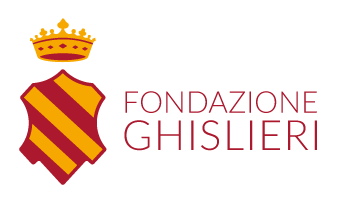WHO WE ARE
The Fondazione Ghislieri gathers a historical and cultural heritage that the Collegio Ghislieri was established in 1567, founded by Pope Pius V, born Antonio Michele Ghislieri.
Today Ghislieri is an articulated reality, resulting from innovations and transformations that have passed through its life, and which is expressed primarily in the Collegio, the Centro di Musica Antica and the Associazione Alunni.
Nowadays Ghislieri is under the High Patronage of the Italian President of the Republic.
HISTORY
Pius V founded the Collegio Ghislieri for young people of limited economic possibilities but gifted with talent, conceiving it as a place to train lay professionals according to the values of the (counter)reformed Church. On 27 November 1567 the first 4 students were appointed and shortly afterwards the Foundation Seal was promulgated, containing the motto which is still the one expressing the spirit and values of the Ghislieri (sapientia cum probitate morum coniuncta humanae mentis perfectio) and a second Seal which allocated a vast patrimony of land to the Collegio to guarantee its economic independence.
The Collegio was immediately provided with a library of 350 volumes that had been specially sent from Venice, at that time a publishing centre of world importance, while the Constitutions that regulate the internal life of the structure were drafted.
In 1771 the patronage of the Collegio, from the Ghislieri family, passed to Maria Teresa of Austria, linking it no longer to a family but to state authority: it was in this context of transformation that the Collegio began to be understood as a forge for the creation of the ruling class.
The arrival in 1796 of Napoleon’s troops, who also put Pavia and its countryside to fire and sword, did not stop the life of the Collegio, which reopened the following academic year with 25 students. These were indeed the years of the brief Rectorate of Giovanni Rasori (1766-1837), professor of pathology and first layman to hold this position. Rasori, among the many initiatives of secular inspiration, drew up a regulation linked to Republican values and replaced the readings of the Holy Scriptures with those of the Lives of Plutarch.
This climate of fervour and change, however, was destined to last little: closed in 1799 and reopened in 1803, Ghislieri from 1805 to 1816 was transformed into a military school.
It returned to being a Collegio in 1818, when the Habsburg eagle was hoisted on the main door. The Napoleonic innovation, still in force today, of providing the Collegio with a Board of Directors was maintained and sixty free places for students were immediately open for “those young people of limited fortune who, having completed the philosophical course, would like to go to the University of Pavia”. The Hapsburg government also promotes the transformation of internal regulations, voting for the rigour and discipline of the students.
Behind the severity imposed by the Habsburg restoration, however, Ghislieri is already transforming itself into a place of ferment and patriotic ideas.
The sentiments of many students (for example: Cesare Correnti, future Minister of Education of the united Italy, and Giuseppe Zanardelli, future Prime Minister) who were to become leading figures in the Risorgimento and the struggle for Italian independence will accompany Ghislieri’s history throughout the early nineteenth century. Ghislieri is a place where many of the protagonists of the Five Days of Milan pass through, where they secretly meet and discuss Mazzini’s ideals and where young people full of ideals and intelligence are preparing to fight for a United Italy.
It is no coincidence that in November 1859, when it reopened under the authority of the Kingdom of Italy, Ghislieri was immediately visited by its new patron, King Vittorio Emanuele II.
In 1861 a decree was approved that regulated entry to the College: the places of students were conferred by examination, thus sanctioning for the first time in Italy the principle of merit in studies as we know it today.
It was also established at that time that scholarships for further education, at home or abroad, could be given to students who distinguished themselves in a particular way.
After a few years Ghislieri, together with the Municipality and the Province of Pavia, granted huge sums to the University to promote new structures and build new ones, saving it from the economic and political difficulties it was in. The Collegio also begins to modernize its structure and services, which transform it, making it unique in Italy at the time.
The activity was interrupted only in the years of the First World War, when the Collegio was transformed into a military hospital and many of its students died at the front. In this troubled period began the Rectorate, which lasted until 1943, of the Roman law scholar Pietro Ciapessoni. During the years of Fascism, Ciapessoni safeguarded the independence of the Institution and contributed important new works of modernization and beautification of the structure, at the same time cultivating and promoting scholarships, especially abroad, for poor but deserving students, who, thanks to the Collegio, were able not only to receive an intellectual education and improve their social condition, but to emerge as professionals and academics appreciated nationally and internationally.
The basis for further development of the Collegio is laid in the brief but significant experience of Master Teresio Olivelli, in 1943. It was in fact Olivelli who launched the idea from which, immediately after the Second World War, the Associazione Alunni del Collegio Ghislieri (would be founded. The main aims of the Alumni Association are: the enhancement of Ghislieri’s tradition (also through the promotion of a sense of belonging, collaboration and solidarity among the students), the support to Ghislieri’s activities and the institution of awards and scholarships for students, the organization of cultural events of various kinds. The Ghislieri College Alumni Association is governed by a Board of Directors democratically elected by all member students every four years. The members of the Board of Directors in turn elect a President.
The Post War Collegio was chaired, from 1945 until 1979, by Aurelio Bernardi, a Roman history scholar who succeeded in crowning the long-planned project of opening a women’s section in 1966, which was established thanks to the benefactor Sandra Bruni. The inauguration saw the arrival of 40 female students at the Collegio: the Ghislieri thus became the first mixed university college in Italy (also anticipating many prestigious British and American institutions).
The last few decades have seen a constant growth in the cultural activities and initiatives proposed and offered by the Collegio, its structures and services.
Ghislieri, in this perspective, has decided to promote its musical activity as well, supporting the Ghislierimusica Association, founded in 2006 by the University Choir of the Ghislieri Collegio. Over time, Ghislierimusica has developed more and more, becoming one of the most active production centres in Italy and Europe in the field of classical and baroque music, performed on period instruments, especially through the concert activity of the resident ensemble Coro e Orchestra Ghislieri, which performs in the most important European festivals. Over the years, Ghislierimusica has developed an important philological research activity on unpublished and rare repertoires, in the baroque and classical field, and has created new projects that bring to light and disseminate the results of research in Italy and Europe. Among Ghislierimusica’s production activities, a particularly significant space is dedicated to artistic residencies at the Collegio Ghislieri. For these reasons, from 2019 Ghislierimusica has become the Centro di Musica Antica della Fondazione Ghislieri: a renewal that takes into account the growth of the structure and its relevance at national and international level.
In 2003, Ghislieri also founded the Centre for Communication and Research, which has now become the University Teaching and Research Centre. The Centre organises courses and seminar activities of advanced training and funds research, especially in the biomedical field, through the provision of scholarships and grants.
In addition to these initiatives, in recent years an important building plan for the construction, extension and enhancement of the structures has been completed. Since the 1980s, the construction of Ca’ della Paglia has been promoted and financed. It started as a residence for graduate students and is now a college of merit, open mainly to PhD students, international students and postgraduate students.
At the turn of the nineties and the early 2000s, Ghislieri took on the task of transforming the church of San Francesco di Paola into the Collegio’s new large Aula Magna, used for major events, concerts and meetings. Just as he had previously been responsible for the restoration of the great architectural complex of the Castle of Lardirago, a splendid building dating back to the 14th century, now equipped and open to exhibitions, shows and events.



